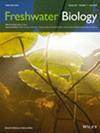浮游生物作为干旱淡水生态系统稳定的基石:从生物多样性到稳定性
IF 2.7
2区 生物学
Q2 ECOLOGY
引用次数: 0
摘要
浮游生物(包括浮游植物和浮游动物)在维持水生生态系统稳定方面发挥着至关重要的作用,但它们对干旱区脆弱淡水生态系统稳定性的影响尚未得到充分探讨。本研究对中国北方代表性干旱区延河流域常见淡水水体(河流和水库)浮游生物的生物多样性动态、共现模式和群落稳定性进行了系统研究。确定了浮游生物群落对关键影响因子的响应阈值。结果表明,尽管与水库相比,干流和支流的浮游生物群落具有更大的多样性和相似性。河流浮游生物网络的鲁棒性和群落稳定性也高于水库,这主要是由于不同类型水体中浮游植物和浮游动物多样性的不同作用。水体养分(如氮源)、pH值、浊度和浮游动物与浮游植物生物量之比(Z/P比)成为影响浮游生物群落结构和稳定性的关键因素。浮游生物群落响应的总氮、pH、浊度和Z/P比值阈值范围分别为0.053 ~ 1.126 mg/L、8.7 ~ 9.0、28.53 ~ 83.23 NTU和0.64% ~ 16.0%。本研究揭示了浮游生物多样性和群落相互作用如何驱动淡水生态系统的稳定性,并为干旱条件下的水资源管理和生态保护提供了操作指南。本文章由计算机程序翻译,如有差异,请以英文原文为准。
Plankton as the Cornerstone of Arid Freshwater Ecosystem Stability: From Biodiversity to Stability
- Plankton (including phytoplankton and zooplankton) play a crucial role in maintaining aquatic ecosystem stability, yet their influence on the stability of fragile freshwater ecosystems in arid regions remains underexplored.
- This study systematically investigated the biodiversity dynamics, co-occurrence patterns and community stability of plankton in common freshwater bodies (rivers and reservoirs) within the Yanhe River Basin, a representative arid region in northern China. The response thresholds of plankton communities to key influencing factors were determined.
- The results indicated greater diversity and similarity among riverine plankton communities in the main stream and tributaries, despite lower biomass compared to those in reservoirs. Plankton network robustness and community stability were also higher in rivers than in reservoirs, mainly due to distinct roles of phytoplankton and zooplankton diversity across different types of water bodies. Water nutrients (e.g., nitrogen sources), pH, turbidity and the ratio of zooplankton to phytoplankton biomass (Z/P ratio) emerged as key factors shaping plankton community structure and stability. The threshold ranges of total nitrogen, pH, turbidity and Z/P ratio for plankton community responses were 0.053 to 1.126 mg/L, 8.7 to 9.0, 28.53 to 83.23 NTU, and 0.64% to 16.0%, respectively.
- This study provides a glimpse into how plankton diversity and community interactions drive freshwater ecosystem stability, and proposes operational guidelines for water resource management and ecological conservation under arid conditions.
求助全文
通过发布文献求助,成功后即可免费获取论文全文。
去求助
来源期刊

Freshwater Biology
生物-海洋与淡水生物学
CiteScore
5.90
自引率
3.70%
发文量
162
审稿时长
2 months
期刊介绍:
Freshwater Biology publishes papers on all aspects of the ecology of inland waters, including rivers and lakes, ground waters, flood plains and other freshwater wetlands. We include studies of micro-organisms, algae, macrophytes, invertebrates, fish and other vertebrates, as well as those concerning whole systems and related physical and chemical aspects of the environment, provided that they have clear biological relevance.
Studies may focus at any level in the ecological hierarchy from physiological ecology and animal behaviour, through population dynamics and evolutionary genetics, to community interactions, biogeography and ecosystem functioning. They may also be at any scale: from microhabitat to landscape, and continental to global. Preference is given to research, whether meta-analytical, experimental, theoretical or descriptive, highlighting causal (ecological) mechanisms from which clearly stated hypotheses are derived. Manuscripts with an experimental or conceptual flavour are particularly welcome, as are those or which integrate laboratory and field work, and studies from less well researched areas of the world. Priority is given to submissions that are likely to interest a wide range of readers.
We encourage submission of papers well grounded in ecological theory that deal with issues related to the conservation and management of inland waters. Papers interpreting fundamental research in a way that makes clear its applied, strategic or socio-economic relevance are also welcome.
Review articles (FRESHWATER BIOLOGY REVIEWS) and discussion papers (OPINION) are also invited: these enable authors to publish high-quality material outside the constraints of standard research papers.
 求助内容:
求助内容: 应助结果提醒方式:
应助结果提醒方式:


